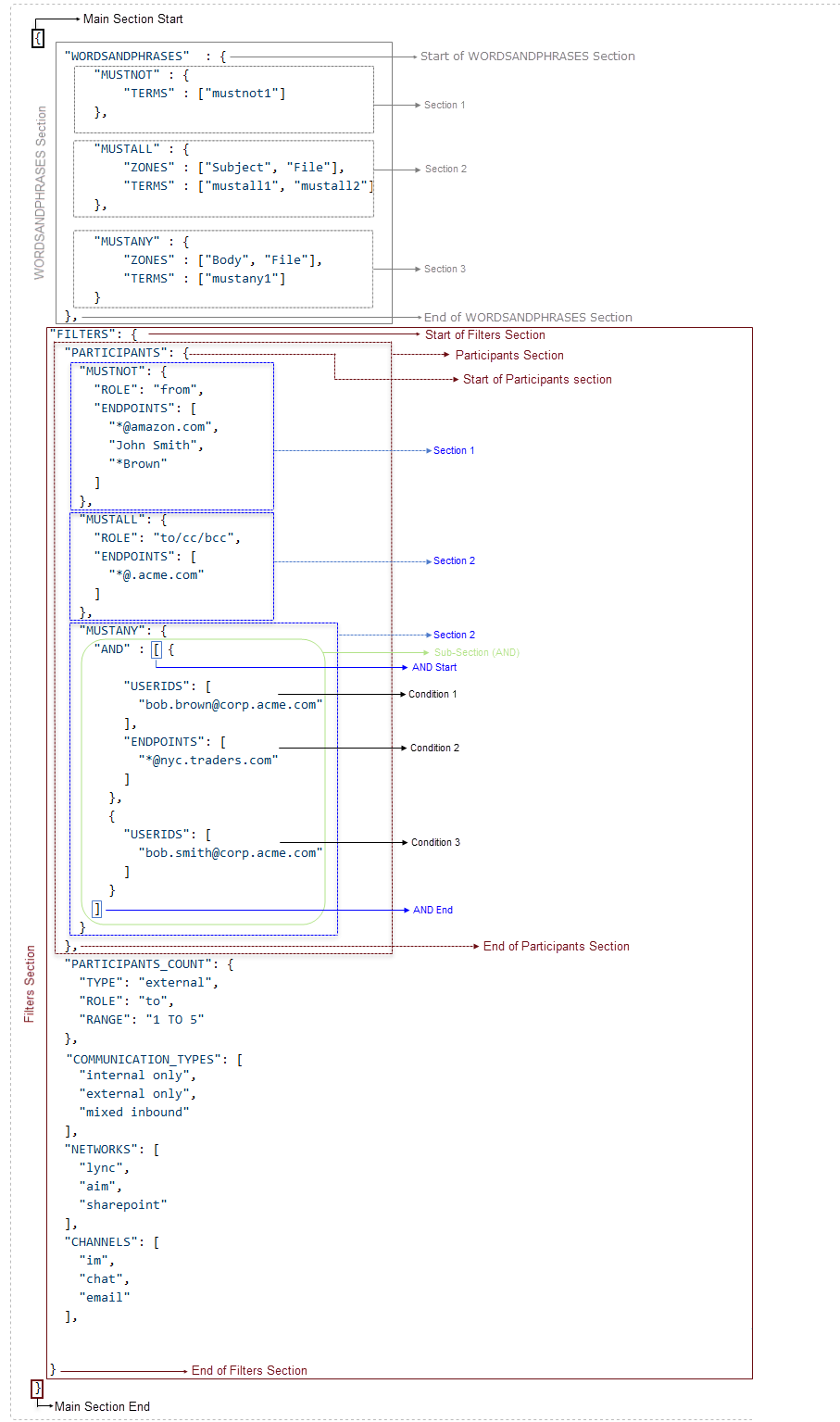Conduct Policy FAQs
The following are common FAQs while creating a Conduct policy:
How to Assemble a Section or a Block?
A section or a block must begin with an open braces " { " and end with a closed braces " } "
All the conditions or sections must be specified within the braces. The word of a phrase in the policy must be specified with in square brackets [ ] .
|
Sample |
Example |
"MUSTNOT" : { <Condition>} |
"MUSTNOT" : { |
Similarly, every section or condition must also begin and end with open and closed braces. Multiple conditions can be specified by separating the conditions with a comma "," after you close a condition with a closed braces " } ".
Warning
Ensure that for every open brace MUST have a closed brace. If not, this causes syntax error.
A complete lexicon policy will have nested sections or conditions, resulting in multiple nested brac e s. While inserting a condition or a section, ensure to place the open and closed braces appropriately.
The following example details how nested conditions are involved in creating a complete lexicon policy. The open and close braces for each section and condition are marked. Ensure to follow the same structure while creating a lexicon policy file.

What are the Limitations in a Proximity Search?
The following limitations do not result in syntax errors:
When alternate terms are used in the context of a proximity term, no alternate term can be a proximity term in itself. That is, the terms either in the left or right of FOLLWEDBY can contain alternates. Those alternates cannot be a proximity.
In the following example, is not a valid term in a sense that it does not mean what it seems. ItValid Example
Invalid Example
High FOLLOWEDBY,2 returns | guaranteed | gains | Profit
High FOLLOWEDBY,2 returns | guaranteed FOLLOWEDBY,1 profits | gains
The above Invalid Example, will not result in an error but instead the alternate proximity term guaranteed FOLLOWEDBY,1 profits will be treated as normal phrase term without any semantic meaning to FOLLOWEDBY.
Proximity terms can be nested. Ensure that the nesting has to be explicitly specified within parenthesis.
Valid Example
Invalid Example
use FOLLOWEDBY,4 (purpose FOLLOWEDBY,2 options)
use FOLLOWEDBY,4 purpose FOLLOWEDBY,2 options
There is no left to right associativity rules but the implementation treats the preceding example as equivalent.
How to Differentiate the Usage of OR and pipe |?
OR is used to combine two or more sections logically, whereas pipe | is used to specify alternating terms or to separate list of terms within a query.
{ "WORDSANDPHRASES": { "MUSTANY": { { "LEXICONS": [ "list1" ] }, { "OR": [ { "TERMS": ["invest", "Hot* FOLLOWEDBY Stock~|tips|news"] } ] } } }}A Conduct Policy Example
{ "WORDSANDPHRASES" : { "MUSTANY" : { "ZONES" : ["Subject"], "TERMS" : ["fundraising","Fed Jones"], "LEXICONS" : ["LexSet1"] } }, "LEXICONS" : { "LexSet1" : ["Unethical","What FOLLOWEDBY,6 happened to my mutual fund","What FOLLOWEDBY,6 happened to my polic*"] }, "FILTERS": { "PARTICIPANTS": { "MUSTALL": { "AND" : [ { "ROLE": "to/cc/bcc", "ENDPOINTIDS" : ["*@aol.com"] }, { "OR" : [ {"ROLE": "to/cc/bcc", "GROUPS": [ "GWM"] }, {"ROLE": "to/cc/bcc", "GROUPS": [ "Advisor"] } ] } ] } }, "NETWORKS":[ "lync", "aim", "sharepoint"], "CHANNELS":[ "journal", "chat", "email", "im"] }}Video Demo
This video demonstrates how to perform a search by uploading a simple Conduct policy.
To view this demo, ensure that Adobe Flash plug-in is installed in your browser. If you still have issues in viewing this demo here are few troubleshooting articles:
|
Browser |
Articles |
|
Firefox |
|
|
Chrome |
https://support.google.com/chrome/answer/6258784?co=GENIE.Platform%3DDesktop&hl=en |
No issues observed in IE and Edge browsers.